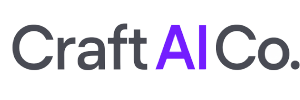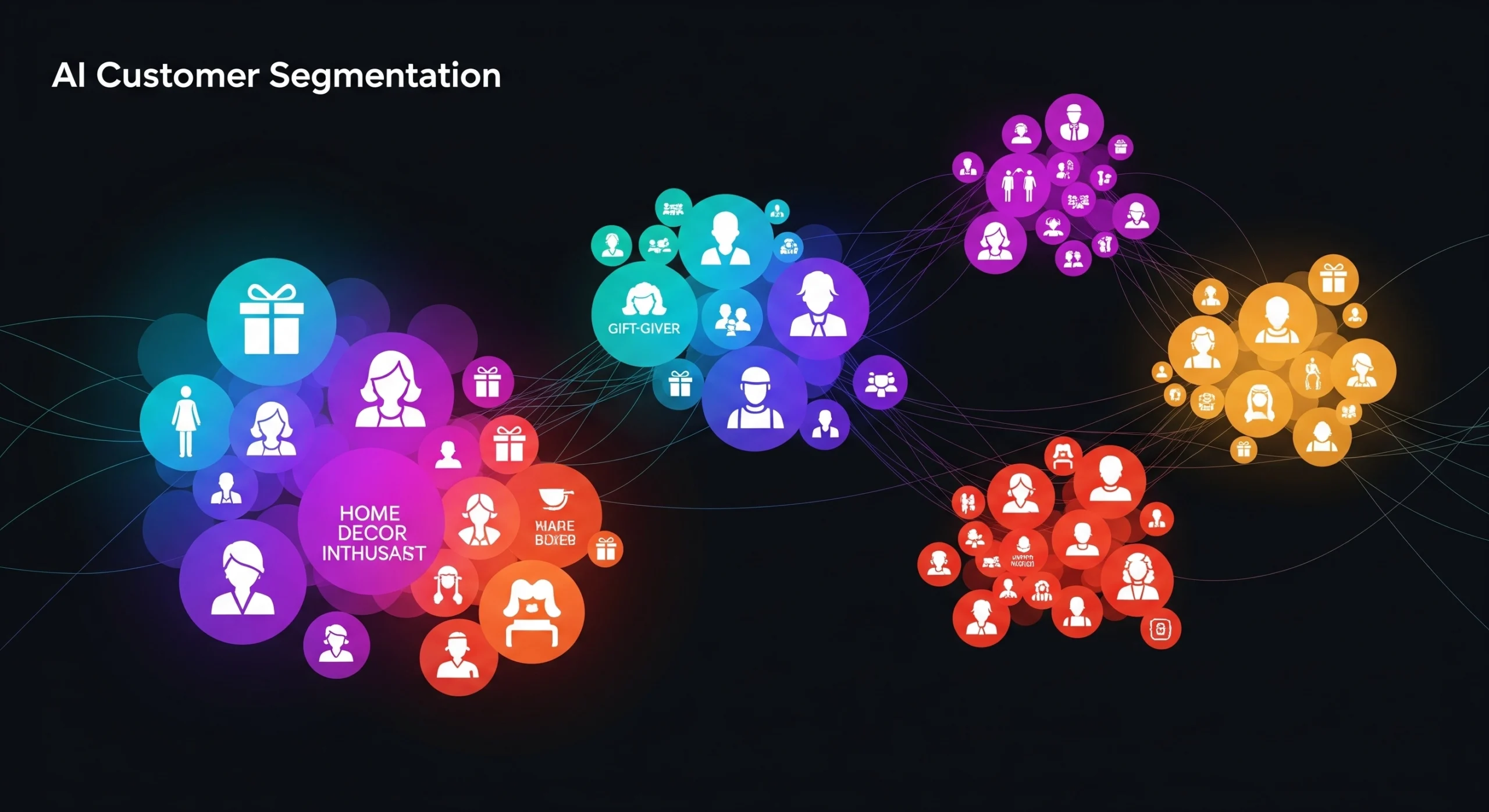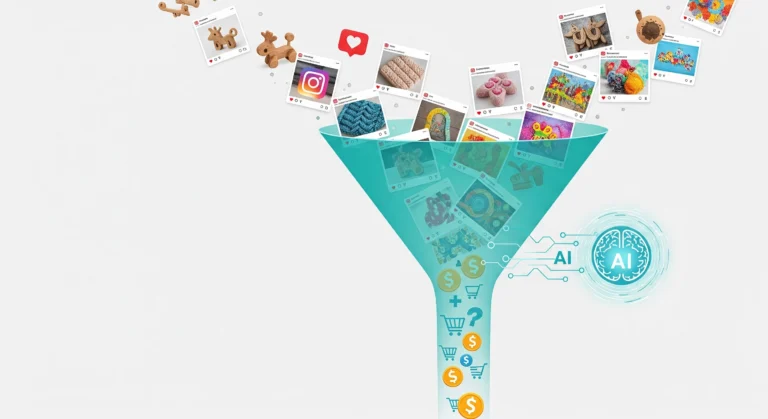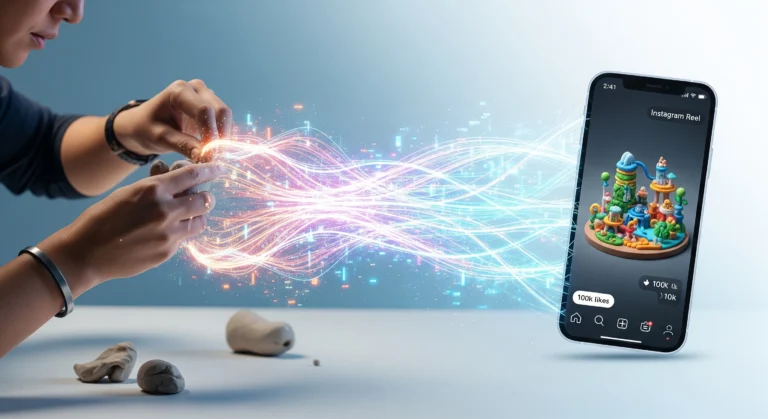Do you feel like you’re creating beautiful, heartfelt marketing but sending it into the void? You know your work resonates with people, but it’s a struggle to reach the right people. The truth is, marketing to everyone is marketing to no one. Studies show personalized marketing can lift revenues by 5 to 15%. What if you could automatically discover who your best customers are—the gift-givers, the home decor enthusiasts, the last-minute shoppers—and speak directly to them?
This is the power of AI customer segmentation. It’s about moving beyond guesswork and using data to create rich, accurate handmade buyer personas. This guide will provide a blueprint for using simple AI tools to understand your audience on a deeper level. By implementing a strategy for AI customer segmentation, you can personalize your marketing, build a loyal community, and turn casual browsers into devoted collectors.
The Strategic Toolkit: Your AI Marketing Analyst
Think of these tools as your personal data scientist, ready to uncover the hidden patterns in your customer base. They are simple to use and designed to deliver powerful insights for your artisan marketing efforts.
- Strategic Foundation: Your existing customer data from Etsy, Shopify, or your email list (even a simple spreadsheet of past orders is a great start).
- AI & Software Stack:
- ChatGPT (with Data Analyst GPT): This is your primary tool. The Data Analyst feature (available in the Plus plan) allows you to upload a spreadsheet of your sales data and ask questions in plain English to perform powerful AI customer segmentation.
- Klaviyo: A powerful email marketing platform with a free tier. Its AI features can predict customer behavior and help you create automated, personalized email flows based on the segments you discover.
- Etsy Stats / Shopify Analytics: The native analytics in your sales platform. These provide the raw data you’ll feed into your AI for deeper analysis.
Time & Resource Investment: Insights in Minutes
Manually sifting through sales data to find patterns could take weeks. AI can do it in the time it takes to brew tea.
- Manual Method Time: 15-20 hours of manually sorting spreadsheets, creating pivot tables, and trying to identify customer patterns.
- AI-Powered Method Time:
- Initial Setup & Data Export: 20 minutes to export your sales data into a CSV file.
- AI Analysis & Segmentation: 15 minutes to upload the data to ChatGPT and ask key questions.
- Ongoing Management: 30 minutes per month to analyze new data and refine your segments.
The ROI: This is a massive reduction in analytical effort, allowing you to spend your time on creative marketing campaigns rather than complex data work. This efficient approach to AI customer segmentation is a game-changer for solo artisans.
The Implementation Blueprint: Your First Customer Segments
Let’s walk through the “2-click” process of performing your first AI customer segmentation. The two clicks are “Upload File” and “Send Message.”
Step 1: Export Your Sales Data (1 Click… or a few) Go to your Etsy Shop Manager or Shopify dashboard and export your order data as a CSV file. The key is to get a spreadsheet with columns like Order Date, Item Name, Order Total, and Customer Location. Don’t worry about cleaning it up perfectly.
Step 2: Upload to ChatGPT’s Data Analyst (1 Click) Open a new chat in ChatGPT, make sure you have the Data Analyst GPT selected, and click the paperclip icon to upload your CSV file.
Step 3: Ask the AI to Segment Your Customers (The Magic) Now, ask simple, powerful questions. This is the core of effective AI customer segmentation. Start with these prompts:
- “Analyze this sales data. What are the top 5 products that are most frequently purchased together?”
- “Create 3 distinct customer segments based on buying behavior. For each segment, give it a fun name, describe its purchasing habits (e.g., average order value, frequency of purchase), and list the types of products it buys most.”
- “Based on the order dates, is there a segment of ‘holiday shoppers’ who only buy between October and December? What do they typically buy?”
- “Identify my ‘whale’ customers who have the highest lifetime value. What are their common characteristics?”
The AI will analyze the entire file and deliver a report defining your unique handmade buyer personas—like “The Sentimental Gift-Giver” or “The Seasonal Decorator.” You have just performed advanced AI customer segmentation without writing a single formula.
Measuring Success: KPIs for Personalized Marketing
How do you know your AI customer segmentation is working? Track the performance of campaigns tailored to each segment.
| Metric | What It Tells You |
|---|---|
| Segment-Specific Email Open Rate | Are your subject lines resonating with that specific buyer persona? |
| Segment-Specific Conversion Rate | Are the products you’re promoting to a segment the ones they actually want to buy? |
| Repeat Purchase Rate by Segment | Is your personalized follow-up turning one-time buyers into loyal collectors? |
Scaling & Advanced Strategies
Your initial segments are just the beginning.
- Behavioral Targeting: Use a tool like Klaviyo to automatically segment customers in real-time. For example, create a segment of everyone who has viewed your “Wedding Gifts” category more than twice but hasn’t purchased, then send them a targeted offer.
- Predictive Analytics: As your data grows, use AI to predict a customer’s next purchase. If your AI customer segmentation identifies a group that buys holiday decor every year, send them a “First Look” email in September before they even start searching.
- Personalized Product Recommendations: Use the insights from your handmade buyer personas to create “You might also like” sections in your emails that are far more accurate than generic recommendations.
Strategic Business Applications
Effective artisan marketing is all about relevance.
- The Soap Maker: Discovers a segment of customers who only buy lavender-scented products. They create a “Lavender Lovers” email campaign showcasing all their lavender items, leading to a huge boost in sales from that group.
- The Pet Portrait Artist: Identifies that their top customers almost always purchase a second portrait within 6 months. They set up an automated email offering a “sibling portrait” discount 4 months after the first purchase.
- The Woodworker: Learns that customers in urban areas buy smaller items like cutting boards, while customers in suburban areas buy larger furniture. They adjust their social media ad targeting accordingly, improving ad spend efficiency.
Common Strategic Pitfalls to Avoid
- Overly-Broad Segments: The point of AI customer segmentation is to get specific. “Customers who like jewelry” is not a segment. “Customers who buy minimalist silver earrings as gifts in December” is a powerful segment.
- Ignoring Qualitative Data: The data tells you what people buy, but your customer conversations and reviews tell you why. Combine these insights for truly effective handmade buyer personas.
- Not Acting on the Insights: The most brilliant AI customer segmentation is useless if you don’t use it to change your marketing. Create campaigns tailored to each segment.
Building Your Content Engine: The Personalization Flywheel
Your system for artisan marketing becomes a powerful loop. You use AI to analyze sales data, creating clear customer segments. You then tailor your marketing messages and product recommendations to each segment. This leads to higher engagement and more sales. This new sales data is then fed back into the AI, further refining your segments and making your next marketing push even more effective.
Conclusion
The heart of your craft business is the unique connection you build with your customers. AI customer segmentation doesn’t replace that connection; it scales it. By understanding who your buyers are and what they love, you can stop shouting into the marketing void and start having meaningful, personalized conversations that build a thriving community and a more profitable business.
FAQs
- Q: Do I need a huge number of sales for AI customer segmentation to work?
- A: Not at all! Even with just 50-100 past orders, an AI tool can start to spot valuable patterns in purchasing behavior, helping you create your first handmade buyer personas. The more data you have, the more refined the segments will become over time.
- Q: Is my customer data safe if I upload it to a tool like ChatGPT?
- A: When using paid tiers like ChatGPT Plus, OpenAI has policies against using your data to train their models. However, it’s always best practice to anonymize data where possible (e.g., removing customer names or addresses) before uploading to any third-party service.
- Q: How is this different from the analytics my sales platform already provides?
- A: Your platform gives you raw data (e.g., top-selling items). AI customer segmentation tools go a step further by interpreting that data to find relationships and build personas. It answers not just “what sold,” but “who bought it, and what else are they likely to buy?”
Ready to unlock the power of personalization for your creative business? Schedule a Call with a Craft AI Co. expert to explore how a custom AI customer segmentation strategy can elevate your artisan marketing.




